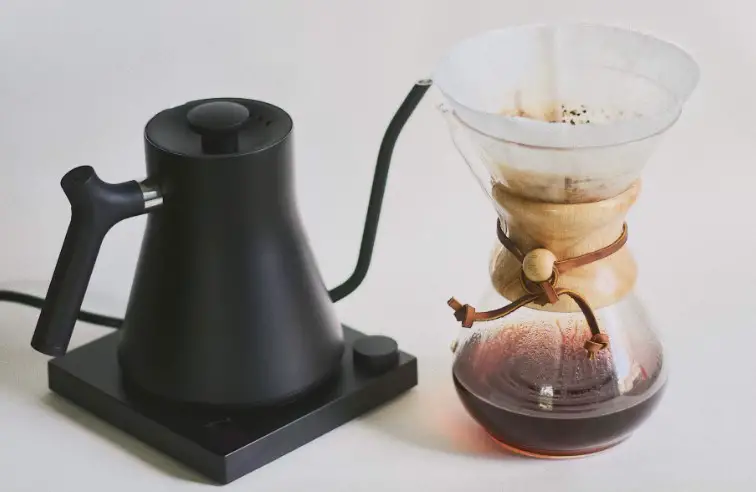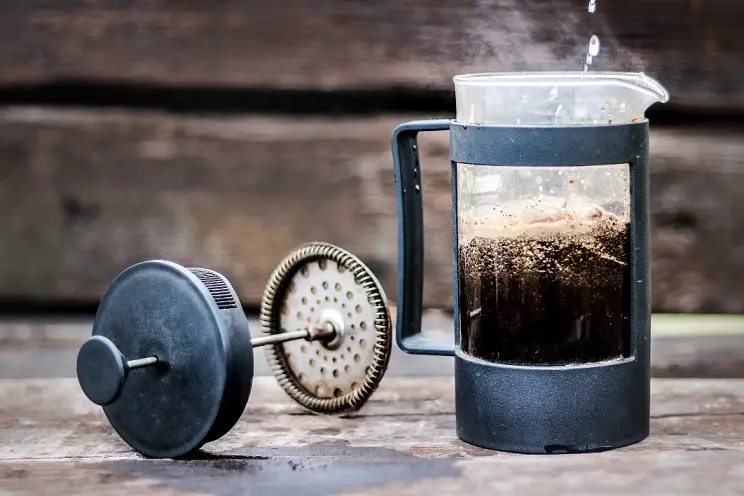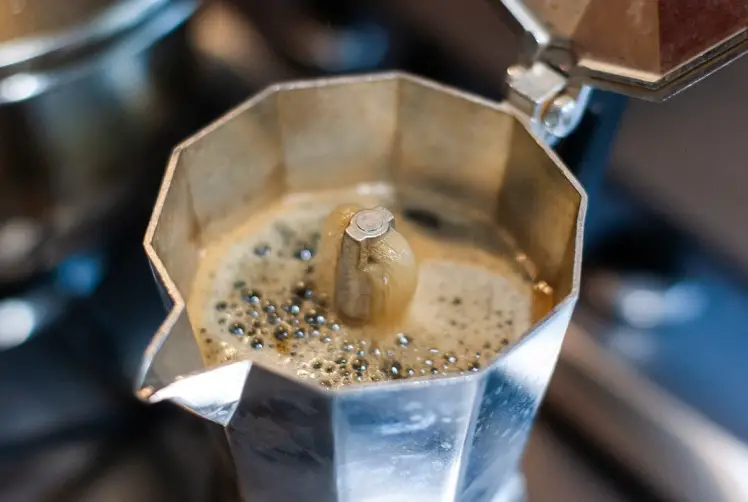Ever since COVID forced me to work from home, I’ve dived into the world of pour-over coffee. At first, my brew tasted quite weak, and it was a bit discouraging.
But I’ve come to realize that many factors can affect the strength of the cup. With some tweaks and experimentation, I’ve managed to craft that strong, flavorful coffee I’ve always wanted. Let’s dive in.
Main Causes of Weak Pour Over Coffee
Insufficient Coffee Grounds
The balance between the amount of coffee used and the water volume is crucial in determining the strength and flavor of your pour-over brew. When you use fewer coffee grounds than necessary, the result is often a brew that lacks depth and richness. This is because there simply aren’t enough coffee compounds to extract.
When I make a standard 12 oz mug, I measure around 25g of coffee to ensure a flavorful cup. This ensures that my brew isn’t overly diluted and maintains a vibrant flavor profile.
Improper Water Temperature
Water temperature is a critical element in the pour-over coffee brewing process. Its significance lies in its direct influence on the extraction of flavors from coffee grounds.
If the water is too hot, it can lead to over-extraction, resulting in a bitter and unpalatable brew. Conversely, water that’s too cool may lead to under-extraction, giving the coffee a flat, weak, or sour profile.
I usually aim for a temperature between 195˚F-205˚F to get a rich and flavorful brew. This also allows for the release of essential oils and aromatic compounds, enhancing the overall sensory experience of the coffee.
Poor Grinding
The consistency and size of your coffee grind can make or break your pour-over experience.
An inconsistent grind size, where some particles are too large while others are too fine, complicates the extraction process. The water will pass quickly through the larger particles, leading to under-extraction, and will linger around the finer particles, resulting in over-extraction.
Moreover, if your grind produces an excess of fine particles, these can accumulate and clog the filter. This not only disrupts the flow of water but also can introduce a sour note to your coffee, as the prolonged contact time causes over-extraction.
Gas Release
Freshly roasted coffee beans are known for releasing CO2, especially during the initial stages after roasting. When water is introduced to coffee grounds, this CO2 release intensifies.
If one were to pour water directly onto the grounds without accounting for this gaseous release, they’d encounter a challenge. The CO2 pushes the water away from the surface of the coffee grounds, effectively creating a barrier against proper extraction.
To fully unlock the flavors and aromas encased in the coffee beans, one must ensure that the water can permeate the coffee grounds unhindered. Neglecting the gas release phenomenon results in a brew that falls short in delivering the full spectrum of coffee flavors.
Common mistakes in Pour Over Coffee
1. Fast Pouring
Pouring water at the right speed over coffee grounds can significantly impact the quality and flavor of your brew. An accelerated pour might seem efficient, but it can inadvertently compromise the all-important “blooming” phase.
During blooming, coffee grounds absorb water, swell, and release gases. This very stage is the foundation for extracting the intricate and diverse flavors that coffee has to offer. A hurried pour can deny you the opportunity to savor a deeply flavorful, aromatic cup of coffee, which is the result of meticulous brewing.
2. Using the Wrong Kettle
Kettle selection isn’t merely a matter of aesthetics or functionality; it plays a significant role in the coffee brewing process. A conventional kettle, although functional, might discharge water in a manner that’s too forceful, disrupting the delicate balance of the coffee grounds.
On the other hand, gooseneck kettles are specifically crafted with the nuances of coffee brewing in mind. They boast a distinctively shaped spout that promises a refined, controlled pour. Such precision ensures that the coffee grounds receive water uniformly, setting the stage for optimal flavor extraction.
3. Neglecting the Bloom
Many might view the coffee bloom as a mere entertaining visual, but it’s so much more than that. It’s an indispensable phase in the brewing process. When you stir the grounds and allow them to bloom, you’re permitting the trapped CO2 gas to be released.
This isn’t just for show; it ensures even saturation of water through the coffee grounds. Neglecting or hastening this phase can have adverse effects. It might lead to uneven water distribution, culminating in a cup of coffee that’s off-balance in its taste and aroma.
4. Incorrect Grind Size:
The nuances of coffee brewing don’t end with water temperature or pouring technique; the grind size of your coffee is paramount. An inconsistent or inappropriate grind can sabotage your coffee experience.
For instance, if your coffee grind is too coarse, it can lead to under-extraction, giving you a cup that’s weak or even sour. It’s of utmost importance to align the grind size with your chosen brewing technique. This alignment ensures that every sip you take offers a well-rounded and harmonious flavor profile, reflecting the true essence of the bean.
How to Fix Weak Pour Over Coffee
1. Adjust Coffee Quantity
To combat a lackluster brew, consider tweaking the amount of coffee grounds you use. The solution might lie in a simple adjustment.
For instance, using a slightly more generous measure, like 4 tablespoons or approximately 25 grams for a standard 12 oz. cup, can make a remarkable difference in the strength and flavor profile of your pour-over. This ensures you have a more concentrated and deeply flavored coffee experience.
2. Mind Your Pour
Pouring isn’t just about getting water from a kettle to your cup. It’s an art and science that directly affects coffee extraction. The key is to pour slowly and steadily, allowing the coffee to bloom initially. Standard kettles can sometimes make this difficult due to their broad spouts.
Therefore, if you’re struggling with precision, consider transitioning to a gooseneck kettle. These kettles are renowned for their precise and controlled pour, which can make a world of difference.
3. Check the Bloom
Bloom – a term every coffee aficionado should be familiar with. It’s an integral part of the pour-over brewing method. Begin your pouring process, then gently stir the grounds. This facilitates the release of CO2, leading the coffee grounds to swell or “bloom.”
Once this bloom settles, continue with a steady pour. By doing this, you allow prolonged interaction between the water and coffee grounds, paving the way for optimal flavor extraction.
4. Perfect Your Grind
The consistency of your grind plays a pivotal role in determining the quality of your brew. Investing in a top-notch burr grinder can be transformative.
Adjust your grinder to produce a fine grind, as this often produces a richer taste. If you encounter issues like slow drainage or excessive fine particles, a tea strainer can act as a rescue tool, ensuring your pour is smooth and consistent.
5. Opt for the Right Equipment
Pour-over can sometimes be tricky, and the right tool can simplify the process. If you’re searching for a more straightforward approach, look no further than the “clever coffee dripper.”
Not only is it user-friendly, but its steeping mechanism, which lasts about four minutes, often yields a more uniform and well-extracted brew, elevating your coffee gam
6. Adjust Water Temperature
Temperature is the unsung hero of the perfect brew. Too hot or too cold, and your coffee can either taste scorched or under-extracted. Once your water reaches boiling point, let it rest for roughly 30 seconds.
This slight pause should bring your water temperature to the ideal range of 195˚F-205˚F, which is considered the golden zone for coffee extraction.
7. Stir or Swirl After Pouring
After the act of pouring, don’t just stand back and wait. A simple act of gentle stirring or swirling can magnify the quality of extraction.
This movement ensures the water is evenly distributed, soaking all the coffee grounds uniformly. By ensuring every ground gets its fair share of water, you’re optimizing the extraction and unlocking the full potential of your coffee beans..




